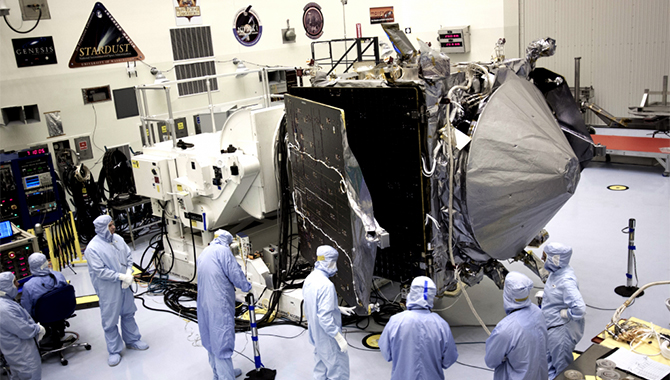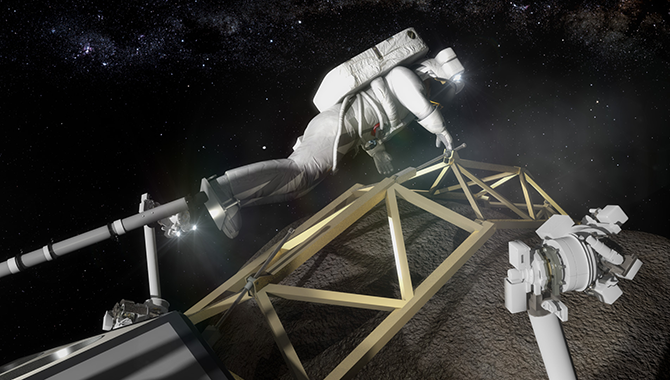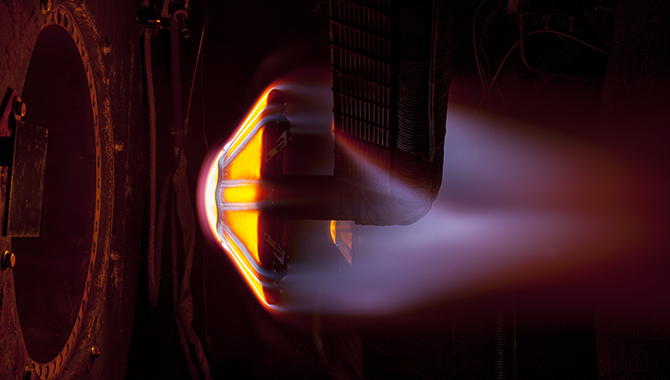
During EM-1, the SLS will transport 13 CubeSats beyond low Earth orbit in order to conduct science experiments and technology demonstrations that will provide critical information for NASA’s deep space program.
Image Credit: NASA
When the Space Launch System (SLS) blasts off for the first time in 2018, it will propel science and technology farther along the journey to Mars.
The SLS, the most powerful rocket in the world and NASA’s first exploration class launch vehicle, is being developed to advance the potential for deep space manned missions. In conjunction with Orion, the first spacecraft designed to carry humans beyond low Earth orbit (LEO) in more than 40 years, the SLS will soar past the moon in 2018 and, on later missions, carry astronauts into cis-lunar space, to an asteroid, and toward Mars.
In order to accomplish these goals, the SLS is built for power. “The rocket itself, the Space Launch System, is 323 feet tall. About 10 feet shorter than the Saturn V, but 20% more thrust than the Saturn V rocket had with Apollo,” said Chris Crumbly, manager of the SLS Spacecraft and Payload Integration/Evolution Office at Marshall Space Flight Center (MSFC).
During its maiden voyage, Exploration Mission 1 (EM-1), the SLS will propel Orion 275,000 miles from Earth in a test of the integrated elements of NASA’s deep space program. But that is not all the mission will accomplish.
“Because of the robust capability of the Space Launch System, we have a unique opportunity to transport small spacecraft and technology experiments on board the very same mission,” said MSFC Director Todd May.
The SLS will carry 13 small satellites. These CubeSats will conduct in-space experiments and technology demonstrations that will actively inform NASA’s future missions. While the science and technology experiments vary greatly in nature, they have one clear goal in common.
“The S and T—the science and technology—gleaned from these missions will advance us on our journey to Mars,” said May.
The CubeSats that will fly on EM-1 were reviewed by NASA’s Exploration Systems Development (ESD) division, which conducted a feasibility study on a number of small satellite candidates before selecting just 13.
“Ten of the CubeSats were selected from in house through competitive processes, such as the Cube Quest Challenge and the [Next Space Technologies for Exploration Partnerships] NextSTEP Broad Agency Announcement, [and] three are international,” said ESD Deputy Associate Administrator Bill Hill. “Each of these CubeSats is complementary to objectives for human exploration and objectives for EM-1.”
Two of the CubeSats are supported by the agency’s Science Mission Directorate (SMD): the Lunar Polar Hydrogen Mapper (LunaH-Map) and the CubeSat to study Solar Particles (CuSP). “[B]oth of these are highly cost-effective scientific missions that are enabled by our investments in technology and also by the contributions from our academic community,” said Michael Seablom, Chief Technologist for the SMD.
“The purpose of the [LunaH-Map] mission is to characterize the distribution of hydrogen that exists in the permanent shadows of the south pole of the moon and the craters and on the plains. Because of the investments we’ve made in technology, this mission, which will carry a neutron spectrometer and also an imager, will give us unprecedented horizontal resolution of the distribution of hydrogen. Roughly seven and a half kilometers per pixel,” said Seablom. The CubeSat is expected to orbit the moon more than 140 times during its 60-day life cycle.
LunaH-Map and CuSP are each roughly the size of a shoebox, but their missions are quite different. “[CuSP] will study the characteristics of solar and interplanetary particles. It will also contribute to our knowledge of space weather forecasting by examining suprathermal particles to better understand their role in contributing to geomagnetic storms,” said Seablom. CuSP will carry three instruments: a Suprathermal Ion Spectrograph, Miniaturized Electron and Proton Telescope, and Vector Helium Magnetometer.
Three CubeSats are being developed as part of the Space Technology Mission Directorate’s (STMD) Cube Quest Challenge. Open to any non-government U.S.-based individual or team, the ongoing competition consists of four ground tournaments, at the end of which three CubeSats will be selected to fly on the SLS.
“This is the first-ever in-space challenge offered by NASA,” said Cube Quest program administrator Jim Cockrell. Some of the selected CubeSats will enter lunar orbit to demonstrate novel technology. Others will go much farther.
“Some teams, rather than going to lunar orbit, they can proceed on to a range from Earth of four million kilometers. Now that’s more than 10 times the distance between the Earth and the moon,” said Cockrell.
According to Cockrell, the Cube Quest Challenge satellites will “demonstrate advancements in propulsions capabilities, communications technology, and—in order to navigate around the moon or distances of four million kilometers—these little CubeSats that are briefcase sized are going to have to advance their capabilities in autonomous operations, and power management, and navigation beyond the constraints of low Earth orbit. These are the kinds of capabilities that CubeSats are going to need as NASA proceeds on its journey to Mars.”
The CubeSats selected as part of NextSTEP are Skyfire, under development by Lockheed Martin, and Lunar IceCube, a project from Morehead State University in Kentucky that will perform low-altitude orbits around the moon to locate water ice and other potential resources on the surface of the moon. Skyfire will also examine the lunar surface during a flyby.
The Human Exploration and Operations Mission Directorate (HEOMD) selected three CubeSats for EM-1: Near-Earth Asteroid (NEA) Scout, BioSentinel, and Lunar Flashlight.
NEA Scout will be the first CubeSat to closely examine an asteroid. “NEA Scout’s going to give you both science and technology objectives. For science, we’re going to image an asteroid: specifically, 1991VG. We’re going to go by close enough, within about one kilometer, and slow enough to see a whole rotation of that asteroid. We’re going to learn a lot about it. We’re going to be able to fill in some of those gaps that scientists have about asteroids. And that will be applicable to future missions to asteroids for really any number of things, including human exploration,” said MSFC NEA Scout project manager Leslie McNutt.
Although NEA Scout will weigh no more than 30 pounds, it will carry an 86-square-meter solar sail for propulsion.
“The NEA Scout is going to demonstrate a new capability for exploration,” said Les Johnson, Principal Investigator for the NEA Scout solar sail. After orbiting the moon, the CubeSat will deploy its sail. “We’ll do that by deploying four 24-foot booms, which will pull out the sail…and that will provide the propulsion system that’ll take NEA Scout to the asteroid. We’ll then do another lunar flyby, get a little bit of a gravity kick from the moon to send us on our trajectory.”
The solar sail will rely on sunlight, not wind, to propel the spacecraft. The sail, which is two and a half microns thick—about the width of a human hair—is made of plastic, with aluminum to give it light reflectivity. “[I]magine light, particles of light, photons, as being like little ping pong balls bouncing off of this [sail],” said Johnson. “And together they impart a little bit of their momentum [so that] the sail will recoil and move. We steer by tipping and tilting the sail, and changing the angle with which the light reflects from the sail. What that does is it changes the net direction of the force or the thrust that allows us to steer the sail in the direction that we want to go. Now this force is a very small force. It’s much less than an ounce per football field. You would never notice it. You can’t feel this pressure. But as long as the sun is shining and our sail is deployed near the sun, we’re going to get constant acceleration from that.”
In demonstrating the solar sail technology, NEA Scout is opening the door to kinds of deep space exploration that haven’t been possible so far. “In the future, solar sails can be made much larger to do other science missions. They have the potential to study the sun, and to go to vantage points that are currently impossible with other propulsion systems,” said Johnson.
Another HEOMD CubeSat, BioSentinel, will conduct an 18-month mission to characterize the impact of radiation on living organisms during long-term human spaceflight.
“One of the biggest problems of deep space human missions that we would encounter is radiation,” said Jitendra Joshi, Technology Integration Lead for the Advanced Exploration Systems Division. “Understanding that radiation damage will help us develop preventive strategies for future human missions to enable safe human spaceflight.”
Finally, the Lunar Flashlight will look for water ice and other resources for possible in-situ utilization during future manned trips to cis-lunar space.
“So you put it all together, and Exploration Mission 1 is going to give us an integrated capability in the proving ground to take the Orion capsule, the Space Launch System, and demonstrate its capabilities. And along for the ride will be a new capability for low-cost interplanetary science and exploration by deploying these CubeSats,” said Johnson.
No space agency has done anything like this before because, until recently, the technology to do so didn’t exist. “This is unprecedented: to take a CubeSat-class payload thousands of miles away from the earth, out into deep space, and to actually conduct science,” said Crumbly.
“Today’s CubeSats represent a culmination of over 10 years of development, mostly by the academic community. The early missions that occurred back in the 2004 to 2005 time frame were largely for educational purposes. And when there was a science payload, they tended to be somewhat pedestrian in nature. Today we have a convergence of the technology for miniaturization of instruments and also advancements in platform capabilities that have come together that have really enabled us to have a new science platform,” said Seablom. “CubeSats and other types of small satellites offer new opportunities for researchers to place their instruments in space. And we’re not talking about investigators just at the large, more familiar institutions. We’re really talking about new investigators from universities that have never before done business with NASA.”
He added, “It’s great to see a very young and diverse set of researchers involved. It really does inspire the next generation.”
Read an APPEL News article about NASA’s Cube Quest Challenge.
Watch a video showing how the SLS will carry and deploy its CubeSats during EM-1.









